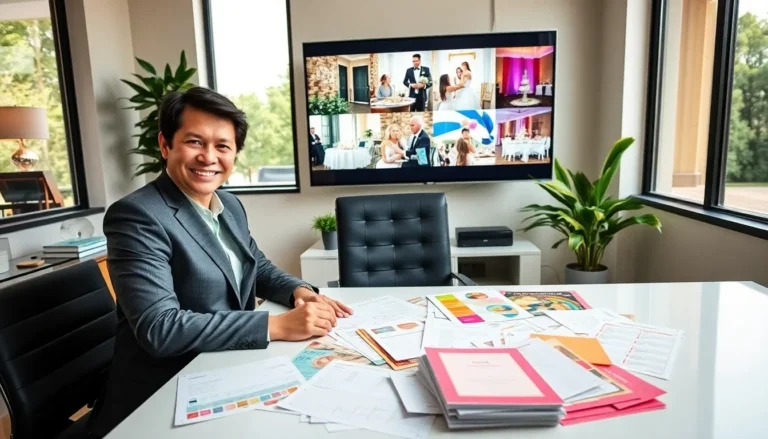Tiny engineers in the making are ready to explore the fascinating world of STEM! Introducing preschoolers to engineering concepts doesn’t require complex equipment or advanced degrees – just creativity and everyday materials that spark curiosity. These early experiences lay the foundation for critical thinking skills and scientific discovery.
From building bridges with popsicle sticks to creating marble runs with paper tubes, engineering activities for preschoolers transform ordinary objects into extraordinary learning opportunities. Parents and teachers can easily incorporate these hands-on experiments into daily routines, making STEM education both fun and accessible for young minds. Plus, these activities help develop problem-solving abilities, spatial awareness, and fine motor skills while kids think they’re just playing.
Table of Contents
ToggleWhat Is STEM Engineering for Preschoolers?
STEM engineering for preschoolers introduces 3-5 year olds to fundamental engineering concepts through playful exploration. The activities focus on building, designing, and problem-solving using age-appropriate materials and methods.
Key Engineering Concepts for Early Learners
STEM engineering for preschoolers focuses on five core concepts:
- Building structures using blocks, LEGO DUPLO bricks or recycled materials
- Understanding cause and effect through simple machines like ramps and pulleys
- Exploring stability by stacking objects or creating balanced towers
- Testing materials to discover properties like strength, weight or flexibility
- Solving design challenges such as creating bridges that support toy cars
These concepts integrate naturally into activities preschoolers already enjoy. Learning happens through hands-on experimentation with tangible objects rather than abstract theory.
Age-Appropriate Engineering Skills
Preschool engineering activities develop specific skills matched to early childhood development:
- Fine motor control through manipulating small objects
- Spatial awareness by arranging shapes and structures
- Pattern recognition in repeated design elements
- Basic measurement using non-standard units
- Sequential thinking through step-by-step construction
- Building towers with increasing height and stability
- Creating simple machines from classroom materials
- Designing solutions to story-based challenges
- Testing and improving their creations through trial and error
- Communicating their ideas through drawings or block structures
Essential Materials for Preschool Engineering Activities
Engineering activities for preschoolers require simple materials found in most homes or classrooms. These materials encourage exploration while maintaining safety standards for young learners.
Basic Building Materials
- Wooden blocks in various shapes sizes for structural activities
- Cardboard boxes tubes from paper towel rolls
- Craft sticks popsicle sticks for creating small structures
- Plastic cups bowls in different sizes for stacking experiments
- Recycled materials: empty containers plastic bottles clean packaging
- Building sets: Duplo blocks magnetic tiles connecting cubes
- Natural materials: smooth stones sticks leaves pinecones
- Play dough modeling clay for shape exploration
- Construction paper card stock for folding activities
- String yarn ribbon for connecting components
Safe Tools and Equipment
- Child sized safety scissors with rounded tips
- Large plastic tweezers tongs for sorting activities
- Measuring tools: rulers tape measures measuring cups
- Magnifying glasses for material examination
- Paint brushes washable markers crayons
- Non toxic glue sticks school glue
- Plastic hammers rubber mallets for safe construction
- Safety goggles sized for small faces
- Storage bins containers for organizing materials
- Clean up tools: dust pans small brooms sponges
Note: All materials listed meet safety standards for children ages 3-5 with proper adult supervision.
| Material Type | Quantity per Group | Safety Rating |
|---|---|---|
| Building Blocks | 20-30 pieces | Age 3+ |
| Craft Sticks | 50-100 pieces | Age 3+ |
| Safety Scissors | 1 per child | Age 3+ |
| Measuring Tools | 2-3 sets | Age 4+ |
Building and Construction Activities
Building projects engage preschoolers in foundational engineering concepts through hands-on exploration of structures. These activities develop spatial awareness while introducing basic physics principles.
Block Tower Challenges
Block tower challenges introduce preschoolers to structural stability concepts. Children stack wooden blocks in various configurations to create towers reaching specific heights. Educators mark measurement lines on a wall chart to track progress achievements. Simple rules enhance learning objectives:
- Build towers taller than three blocks
- Create structures using 10 blocks
- Stack blocks in alternating patterns
- Design towers that support small toys
- Construct bases with different shapes
A timer adds excitement while children experiment with different building techniques. Documentation cards enable students to draw their successful designs for future reference.
Bridge Building Projects
Bridge building activities teach preschoolers about spans support systems. Materials include:
| Basic Materials | Quantity per Group |
|---|---|
| Popsicle sticks | 20-25 pieces |
| Building blocks | 8-10 pieces |
| Cardboard strips | 5-6 pieces |
| Play dough | 2-3 containers |
Children create bridges between two points using these materials. Activities progress through stages:
- Connect two blocks with a single stick
- Build bridges that hold small toys
- Create bridges spanning longer distances
- Design multiple support structures
- Test different bridge shapes
Teachers measure bridge strength by adding counting bears as weight tests. Students record successful designs through photographs or drawings.
Simple Machine Experiments
Simple machines introduce preschoolers to fundamental physics concepts through hands-on experimentation. These activities demonstrate how basic mechanical principles work in everyday objects while developing critical thinking skills.
Ramps and Rolling Objects
Ramps demonstrate gravity principles through engaging experiments with everyday items. Preschoolers explore incline variations using cardboard planks at 3 different angles: 15°, 30° & 45°. Rolling objects like marbles, toy cars or tennis balls down ramps teaches concepts of speed, distance & momentum. Testing surface materials changes friction effects – smooth surfaces like wax paper create faster rolls than rough surfaces like sandpaper. Children record results by marking stopping points with masking tape or measuring distances with building blocks.
Pulley Systems for Kids
Pulley experiments transform complex mechanical concepts into playful learning opportunities. A basic pulley setup uses a rope threaded through a fixed wheel to lift lightweight objects like stuffed animals or plastic buckets. Adding multiple pulleys demonstrates mechanical advantage as children notice reduced lifting effort. Simple materials create working systems: plastic wheels, string, dowel rods & mounting brackets. Children test different configurations by lifting identical objects with 1, 2 or 3 pulleys while counting required pulls. Safe experimentation parameters include 2-pound maximum weight limits & adult supervision during setup.
Engineering Design Process for Preschoolers
Engineering design for preschoolers focuses on a simplified process that encourages exploration through structured play. This adapted approach breaks down complex engineering concepts into manageable steps for young minds.
Problem-Solving Through Play
Preschoolers engage with engineering challenges through guided play activities that spark natural curiosity. Teachers set up scenarios like “build a house for three toy bears” or “create a bridge for toy cars” to introduce basic problem identification. Children explore multiple solutions using materials such as blocks, cardboard tubes or craft sticks. This process develops critical thinking skills as they identify problems, brainstorm ideas and select materials. Play scenarios incorporate measurement concepts by comparing sizes, counting pieces and discussing spatial relationships between objects.
Testing and Improving Solutions
Testing solutions becomes an exciting discovery process as preschoolers experiment with their creations. Young engineers test their designs through hands-on trials, such as seeing if their block tower stays standing or if their paper airplane flies. Documentation happens through simple drawings, photos or verbal descriptions of what worked and what didn’t. Teachers guide improvement by asking open questions like “What could make your bridge stronger?” or “How can we help the plane fly farther?” Children modify their designs based on test results, learning that failure creates opportunities for enhancement rather than disappointment.
Incorporating Nature and Recycled Materials
Natural elements enhance engineering activities for preschoolers by providing unique textures materials that spark curiosity experimentation. These materials offer cost-effective sustainable alternatives to traditional building supplies while teaching environmental awareness.
Outdoor Engineering Adventures
Preschoolers collect sticks leaves rocks to construct natural forts dams in outdoor spaces. The varied shapes textures of natural materials let children explore weight distribution balance through hands-on experimentation. Pine cones serve as pulleys rocks become anchors twigs transform into levers as children create simple machines. Outdoor spaces provide opportunities for large-scale engineering projects like:
- Building stone bridges across shallow streams
- Creating mud brick structures using natural clay soil
- Designing leaf boat racing systems in water tables
- Constructing bird nests using gathered twigs grass
- Assembling nature-based weather stations with found items
Sustainable Building Projects
Recycled materials form the foundation of eco-friendly engineering activities for preschoolers. Empty cardboard boxes transform into towers cities while plastic containers become boats floating vessels. Children learn material properties through these everyday items:
- Cardboard tube marble runs demonstrate gravity motion
- Bottle cap sorting systems teach classification patterns
- Paper roll construction sets build spatial awareness
- Egg carton building blocks explore structural integrity
- Plastic bottle greenhouses demonstrate plant growth
Each project incorporates measurement estimation skills while introducing concepts of reuse recycling. Teachers document these activities through photos encouraging children to discuss their design choices material selections.
Tips for Teaching Engineering to Preschoolers
Teaching engineering concepts to preschoolers requires specific strategies that make learning engaging while maintaining educational value. These tips focus on creating the right environment and fostering a positive attitude toward experimentation.
Creating an Engineering-Friendly Environment
An engineering-friendly preschool environment promotes active exploration through strategically organized spaces. Set up dedicated zones for building blocks wooden toys manipulatives. Organize materials in clear labeled containers at child height for easy access. Display photos of real-world engineering examples bridges buildings machines on classroom walls. Include storage solutions for works in progress so children can return to their projects. Position engineering materials near natural light sources to enhance visibility during construction activities. Create a testing area with ample floor space for children to try out their creations.
Encouraging Trial and Error
Preschoolers learn engineering concepts through repeated experimentation with different approaches. Teachers model positive responses to unsuccessful attempts by saying “Let’s try another way” or “What else could work here?” Document children’s attempts through photos sketches notes to track their progress. Celebrate innovative solutions even when they don’t succeed. Ask open-ended questions like “What happened when…?” to promote analytical thinking. Give children time to test modify rebuild their designs without rushing to solutions. Create challenges with multiple possible solutions to demonstrate that engineering problems often have many answers. Share examples of real engineers who improved their designs through multiple iterations.
Conclusion
Engineering activities for preschoolers create a strong foundation for future STEM learning through playful exploration and discovery. These hands-on experiences develop critical thinking abilities spatial awareness and problem-solving skills while children have fun building creating and experimenting.
By providing age-appropriate materials setting up engaging challenges and encouraging trial and error educators and parents can nurture young engineers’ natural curiosity. The key is maintaining a supportive environment where children feel confident to explore test and improve their designs.
Through these early engineering experiences preschoolers develop essential skills that’ll benefit them throughout their academic journey and beyond. When combined with positive guidance and open-ended exploration these activities help create the next generation of innovative thinkers and problem solvers.







